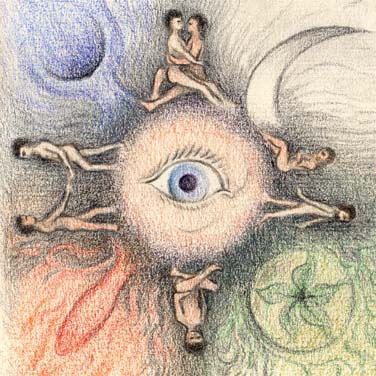

Figures depicting the changes and turnings in a relationship circle around the eye of divine consciousness. Symbols of the suits of the Intimacy tarot adorn the corners.
Change is the very essence of life. One thing leads to another; stasis is an illusion. When we are young, changes often seem random, incoherent, delightful or brutal. With wisdom comes the understanding that many changes are simply stages in natural patterns of growth: life, death, and rebirth alternating in a deep rhythm, like the heartbeat of our world.
It can be difficult to accept change in a relationship. We are raised with fairy tales that end, "and they lived happily ever after" - a kind of static pleasantness held up as an ideal. Attempts to create an unchangingly happy atmosphere in a relationship are usually doomed from the outset. Attraction, communion, discord, and estrangement are phases in the rhythm of a relationship, like waves coming ashore. What matters is not the existence of the cycle, but what the energy balance is between the different phases. In growing relationships, periods of conflict give birth to stronger forces of love than existed before. In a relationship that is dying, conflict builds on itself, and the interludes of love and connection become drained, spending themselves too soon.
The cycle on the card can be seen as depicting the progress of a single relationship from inception to death, and then a return to the beginning of a new relationship. It may sometimes be so, but more often it is not about a change of partners, a permanent loss, or a brand new relationship. Rather, it reminds of the cycles of change within a relationship, and our need to recognize and accept them. The eye in the center is the knowing watcher, unblinking and unsurprised by the turnings of the wheel, its gaze fixed forward along the wheel's axis, not outward to its spinning perimeter.
There is a tension between indentifying with the figures on the wheel, with their joys and disappointments, and identifying with the fixed center, where change seems arbitrary and inconsequential. In the end, we probably need to have both perspectives in our repertoire. We must live on the wheel if we are to live at all. If we abstract ourselves too much from the turns of our own life, we become vacuous spectators, feeling nothing. But if we imagine each change in fortune as a blast of fate, with no context and no purpose, then we become slaves to events, not conscious beings.
To appreciate the dance of life means appreciating all its phases. True beauty, and true health, cannot be frozen in a snapshot of a perfect moment, rather they are properties of the entire system, and the entire life cycle of human growth and change.